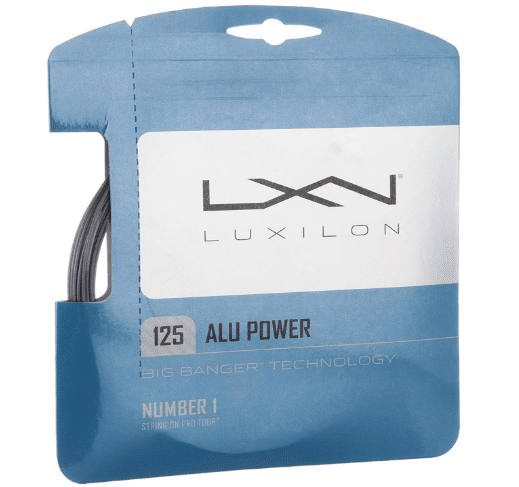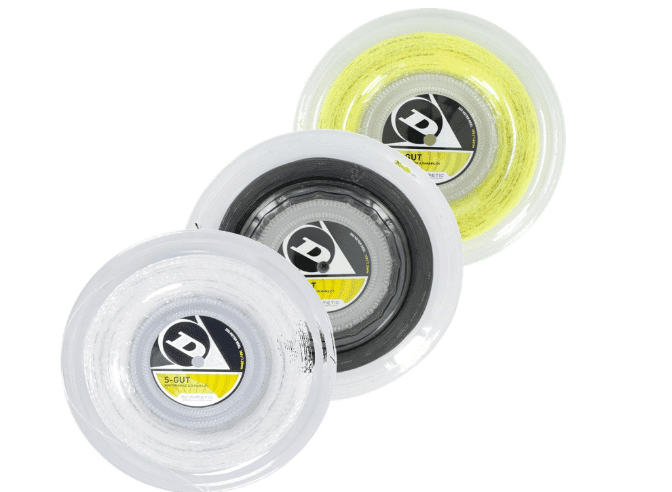Because the string makes contact with the tennis ball, it is the most crucial component of a racquet. Your performance will suffer if it is loose or of low quality.
Investing in Best Tennis Strings For Wrist Pain is crucial if you want to improve as a player and build a profession out of tennis. This tennis string buying guide provides you with all the information you need to make an informed decision.
Top 10 Tennis Strings For Wrist Pain
Image | Name | Key Feature | Ratings | Price |
|---|---|---|---|---|
| ||||
| ||||
| ||||
| ||||
|
Our Top 5 Best Best Tennis Strings For Wrist Pain Reviews
- Massive Spin from a square shaped co-poly
- Crisp and medium firm
- Permits hard hits with no loss of control
- Ball Explods off strings with high spin
- HEAD PERFORMANCE: Born out of revolutionizing how we ski and play tennis, HEAD has constantly pushed...
- TOURNAMENT LEVEL: The Velocity MLT is a premium multifilament string with a lively feel that's great...
- COMPOSITION: The 17 g tennis string features a multifilament core surrounded by thicker filaments...
- HIGH SPIN POTENTIAL: A special low friction coating ensures the strings perfectly re-align after...
- AN IDEAL PAIRING: An excellent match for your favorite HEAD Tour racket for top level performance.
- HEAD PERFORMANCE: Born out of revolutionizing how we ski and play tennis, HEAD has constantly pushed...
- TOURNAMENT LEVEL: A well-blended easy-to-handle multifilament string perfect for the versatile...
- RIP TECH: Thanks to the exclusive RIP Technology (which also gives the string its name), the...
- COMPOSITION: A thin composite string, RIP Control combines copolymer nylon fibers and polyolefin...
- AN IDEAL PAIRING: An excellent match for your favorite HEAD Tour racket for top level performance.
- Luxilon ALU Power 125 Tennis String - Set, Silver
- Top string on Pro Tour - used by roughly 60% of top 100 players
- Superior power, control and spin potential
- Contains Luxilon's unique poly-ether-ether material
- Completely impervious to atmospheric conditions such as moisture
Last update on 2025-03-09 / Affiliate links / Images from Amazon Product Advertising API
Best Tennis Strings For Wrist Pain - Buying Guide
size and thickness
The player's experience is profoundly affected by the string's tension, as well as its size and thickness. The importance of making a wise decision while selecting them cannot be overstated. Rope, like clothing, is often available in various sizes or diameters that may be used to make pricing comparisons. In the industry, gauge, measured in millimeters, is the preferred term. In the business world, 1.15 mm and 1.40 mm are standard sizes.
If you want your string to last as long as possible, remember that the thicker it is, the better. However, the speed of your ball may be affected by such a surface. In contrast, a reasonably thin string will allow more maneuverability while still ensuring the ball travels in the path you set.
Compatibility
The tennis player's age is considered while selecting the appropriate size racket. One for adults measures between 68.5 cm and 71 cm in length, while one for children ranges in size from 50 cm to 67.5 cm. The screen's uprights may have 14, 16, or 18 ropes, while the crosses can have 15, 18, 19, 20, or 22 ropes.
Given these numbers, it's clear that you need to examine your racket's specifications to see whether a specific tennis string will work with it before making a final decision.
You and I may discuss how well the string works with your playing style. Usually, experts modify it to achieve specific goals, such as increased strength, accuracy, tolerance, or comfort.
Usability and assembly
Given the frequency (every other day or more) a tennis player may need to restring their racquet, the ability to do so is an absolute need. A rope can hold its tension for around twenty-four hours. The tension will have been released. Therefore, retightening may be required.
Although sporting goods stores do a great job with it, it is impractical always to have to make a memorable trip there. If you need a new tennis string and don't know where to get one, you should at least visit a shop that can accommodate your needs. Manual labor might take many hours. To avoid the hassle, we advise investing in an automated stringing machine. A fresh string will take you around half an hour on average.
Use a monofilament string instead of a multifilament one to keep from needing to thread your racket as often. We hope these few suggestions will assist you in finding a higher-quality tennis string at an affordable price.
Tennis String Material
The following materials are often used to construct strings.
Natural Gut
This string, manufactured from cow intestines, has the highest stability, control, and spin levels of any commercially available string. Though it's one of the priciest string materials, it doesn't last as long as other synthetic alternatives.
Unfortunately, only skilled or professional tennis players can afford to utilize natural gut. To this day, nylon and polyester string remain the most popular choices for club and intermediate-level players.
Synthetic or Nylon Gut
Nylon is often meant when someone says they use "synthetic gut" strings. You won't have as much command over your instrument, but the strings have a better feel and last longer than those made from natural gut.
Novices and confidence intermediates prefer nylon since it is less expensive than natural gut and helps protect against tennis elbow.
Polyester
For the better part of the previous several decades, polyester tennis strings have dominated the market, making them the go-to choice for serious players. "Poly" string, as it is more often called, is the strongest string available. However, it is rather stiff and not recommended for those who suffer from tennis elbow. Comfort is sometimes increased by using a gut string in conjunction with a poly string.
If you are an experienced club player who often has string breakage, you may want to switch to polyester strings.
Tennis String Construction
Manufacturers have many options on how to produce tennis strings.
Monofilament String
You must make a monofilament if you want to make a string but only one strand. Close inspection of its profile reveals a central solid component. Most poly strings are constructed in this way.
Advanced players sometimes choose monofilament strings because of their excellent durability and control, yet these strings often come at the expense of playability, power, and feel.
Multifilament String
As the name implies, a multifilament string is constructed from more than one filament. The material makeup of these strings often includes nylon, polyester, or a hybrid of the two. Hundreds or even thousands of strands are woven together to create multifilament strings.
These strings last longer than monofilaments but fray and break more easily, benefiting players with tennis elbows.
Co-Poly String or Composite String
Occasionally, a string will have a monofilament core wrapped in a multifilament sheath. A composite string describes this kind of string. In the same way, a co-poly string is mostly polyester but also includes other elements.
Several of our top selections are co-poly strings, and this trend is only expected to grow.
Textured String
Numerous string companies have introduced textured strings in recent years. Textured strings do not have a spherical shape when examined under magnification after being cut. Edges are added to the design to aid the string in grabbing the ball and increasing spin. Hexagonal, octagonal, or twisted shapes predominate among textured string types.
Best Tennis Strings To Reduce Wrist Pain - FAQ
Is there a connection between tennis performance and string quality?
Numerous facets of tennis can't be separated from the strings. Choosing the correct string may improve a player's performance. If a player wants more incredible velocity on their strokes or more control over their shots for more consistent performance in rallies, a change of tennis strings may be the answer. The tennis string you choose is a significant factor in protecting your body and avoiding injuries. Tennis elbow may be caused by using the wrong string. Think about the money aspect, too. There is no use in using the string that breaks every week if you perform at a lesser level than the one it was designed for.
WHY SHOULD I RESTRING MY RACKET REGULARLY?
The strings, which account for half of your racket, are the parts that make contact with the ball. They're as crucial as your racket itself. Power, precision, ease, and playability are all attributes of your shots that may be attributed to the quality of your strings. As time passes, the string eventually dies. Dead strings no longer have any resiliency, tension, or playability. Your game will suffer as you lose strength, precision, and feel. It takes a lot more effort to hit the ball, so many players become acclimated to the sensation and resort to muscle swings to achieve any force.
Notably, dead strings have zero resilience when struck. This soundwave can only resonate in one direction. I mean, look at your arm! Ouch! Tennis elbow could be a severe problem for you right now. If not, your chances of acquiring it will increase dramatically.
Even while not in use, strings gradually lose tension.
After around 20 hours of use, strings have lost almost all of their playing qualities. If you're a casual musician, you should probably rest your instrument every 52 weeks. So, if you play tennis three times a week, you should rest your strings every three months.
You should restring every three to four months to get the most out of your strings. If you play less often but with more people, you should change your strings once a year for every week you play. Remember that string tension is permanently lost, even while you're not playing.
If you want to know when and why you should change your strings, watch this video of Lucien.
HOW DO I KNOW WHICH STRING TO USE?
Synthetic gut or multifilament strings are great options for club tennis players who don't break strings monthly. A complete bed of multifilament, such as Wilson Sensation, is what I'd suggest trying out. This string is effective in tension retention, comfort, ease of use, and output. It works well on the arm, too. The durability of this string is the only minor downside.
Consider ordering the heaviest gauge available for it, size 15, if you're worried about its longevity. Prince Synthetic Gut with Duraflex is another option that is both highly rated and more long-lasting than the sensation.
Contrary to polyester, these string kinds are gentle on the arms. If you're an intermediate tennis player, don't bother using polyester string.
If you play one or twice a week, these strings should last a while. But if you go through a pack of these strings in less than a month, you may want to look into some replacements. Another option is a hybrid string setup, which uses polyester for the mains and softer material, like feeling, for the crossings. If you plan on using this configuration, I suggest lowering the tension to the low 50s.









